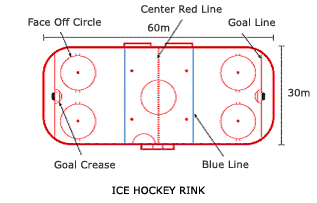There are 3 basic rules in hockey that have a negative outcome: Offside, Icing, and Penalties.
When a player breaks the rules he is penalised by the referee and sent off the rink for 2, 5 or 10 minutes, or in some cases until a goal is scored by the team with the most players on the rink.
An ice hockey match is played over three periods of 20 minutes each, with frequent substitutions between players (unlike football, there are no limits, and substitutions can occur during play) and with a 15 minute intermission between each period.

The standard international dimensions of an ice hockey rink are 60 metres long and 30 m wide. The ice is surrounded by a wooden or plastic wall, known as "the boards," which are approximately 1.22 m high.
A red centreline divides the rink in half; two blue lines divide the rink into three zones: defensive, neutral and attacking. In addition to the centre circle, there are four face-off circles – two in front of each goal. Regulation goals are made of a metal framework with a net and measure 1.83 m wide by 1.22 m high and 1.12 m deep. Goals are centred on the goal line and set four metres away from the backboards so players can skate behind them.
The term hat trick – a series of 3 goals in one game, is always associate with hockey.






























